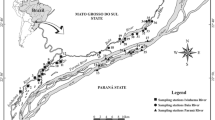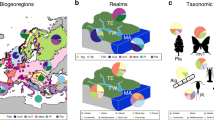Abstract
Biological diversity comprises both species richness, i.e., the number of species in a community, and evenness, measuring how similar species are in their abundances. The relationship between species richness and evenness (RRE) across communities remains, however, a controversial issue in ecology because no consistent pattern has been reported. We conducted a systematic meta-review of RRE in aquatic ecosystems along regional to continental gradients and across trophic groups, differing in body size by 13 orders of magnitude. Hypotheses that RRE responded to latitudinal and scale variability across trophic groups were tested by regression analyses. Significant correlations of species richness and evenness only existed in 71 out of 229 datasets. Among the RRE, 89 were negative and 140 were positive. RRE did not vary with latitude but showed a positive response to scale. In a meta-analysis with ecosystem type as a single explaining variable, RRE did not vary among ecosystem types, i.e. between marine and freshwater. Finally, autotrophs had more positive RRE than heterotrophs. The weak RRE in many aquatic datasets suggests that richness and evenness often reflect independent components of biodiversity, highlighting that richness alone may be an incomplete surrogate for biodiversity. Our results further elucidate that RRE is driven by organismal and environmental properties, both of which must be considered to gain a deeper understanding of large-scale patterns of biodiversity.



Similar content being viewed by others
References
Altieri AH, Trussell GC, Ewanchuk PJ, Bernatchez G, Bracken MES (2009) Consumers control diversity and functioning of a natural marine ecosystem. Plos One 4:e5291
Azovsky A (2002) Size-dependent species–area relationships in benthos: is the world more diverse for microbes? Ecography 25:273–282
Burnham KP, Anderson DR (2002) Model selection and inference: a practical information-theoretic approach. Springer, New York
Connell JH (1978) Diversity in tropical rain forests and coral reefs—high diversity of trees and corals is maintained only in a non-equilibrium state. Science 199:1302–1310
Cotgreave P, Harvey P (1994) Evenness of abundance in bird communities. J Anim Ecol 63:365–374
Crow GE (1993) Species-diversity in aquatic angiosperms—latitudinal patterns. Aquat Bot 44:229–258
Dangles O, Malmqvist B (2004) Species richness-decomposition relationships depend on species dominance. Ecol Lett 7:395–402
De Benedictis PA (1973) Correlations between certain diversity indexes. Am Nat 107:295–302
Drobner U, Bibby J, Smith B, Wilson JB (1998) The relation between community biomass and evenness: what does community theory predict, and can these predictions be tested? Oikos 82:295–302
Finlay BJ (2002) Global dispersal of free-living microbial eukaryote species. Science 296:1061–1063
Gonzalez A, Lawton JH, Gilbert FS, Blackburn TM, Evans-Freke I (1998) Metapopulation dynamics, abundance, and distribution in a microecosystem. Science 281:2045–2047
Gosselin F (2006) An assessment of the dependence of evenness indices on species richness. J Theor Biol 242:591–597
Hautier Y, Niklaus PA, Hector A (2009) Competition for light causes plant biodiversity loss after eutrophication. Science 324:636–638
Hill MO (1973) Diversity and evenness—unifying notation and its consequences. Ecology 54:427–432
Hillebrand H (2004) On the generality of the latitudinal diversity gradient. Am Nat 163:192–211
Hillebrand H, Gruner DS, Borer ET, Bracken MES, Cleland EE, Elser JJ, Harpole WS, Ngai JT, Seabloom EW, Shurin JB, Smith JE (2007) Consumer versus resource control of producer diversity depends on ecosystem type and producer community structure. Proc Natl Acad Sci USA 104:10904–10909
Hillebrand H, Bennett DM, Cadotte MW (2008) Consequences of dominance: a review of evenness effects on local and regional ecosystem processes. Ecology 89:1510–1520
Jost L (2010) The relationship between evenness and diversity. Diversity 2:207–232
Kirwan L, Luescher A, Sebastia MT, Finn JA, Collins RP, Porqueddu C, Helgadottir A, Baadshaug OH, Brophy C, Coran C, Dalmannsdottir S, Delgado I, Elgersma A, Fothergill M, Frankow-Lindberg BE, Golinski P, Grieu P, Gustavsson AM, Hoglind M, Huguenin-Elie O, Iliadis C, Jorgensen M, Kadziuliene Z, Karyotis T, Lunnan T, Malengier M, Maltoni S, Meyer V, Nyfeler D, Nykanen-Kurki P, Parente J, Smit HJ, Thumm U, Connolly J (2007) Evenness drives consistent diversity effects in intensive grassland systems across 28 European sites. J Ecol 95:530–539
Korhonen JJ, Soininen J, Hillebrand H (2010) A quantitative analysis of temporal turnover in aquatic species assemblages across ecosystems. Ecology 91:508–517
Magurran AE (2004) Measuring biological diversity, 1st edn. Blackwell, Oxford
Passy SI (2010) A distinct latitudinal gradient of diatom diversity is linked to resource supply. Ecology 91:36–41
Peters RH (1983) The ecological implications of body size. Cambridge University Press, Cambridge
Rahbek C (2005) The role of spatial scale and the perception of large-scale species-richness patterns. Ecol Lett 8:224–239
Rajaniemi TK (2002) Why does fertilization reduce plant species diversity? testing three competition-based hypotheses. J Ecol 90:316–324
Reynolds CS (2006) The ecology of phytoplankton. Cambridge University Press, Cambridge
Rivadeneira MM, Thiel M, Gonzalez ER, Haye PA (2011) An inverse latitudinal gradient of diversity of peracarid crustaceans along the pacific coast of South America: out of the deep south. Global Ecol Biogeogr 20:437–448
Rosenberg MJ, Adams DC (2000) Metawin 2.0 User`s manual: statistical software for meta-analysis. Sinauer, Sunderland
Schemske DW, Mittelbach GG, Cornell HV, Sobel JM, Roy K (2009) Is there a latitudinal gradient in the importance of biotic interactions? Annu Rev Ecol Evol Syst 40:245–269
Shurin JB, Gruner DS, Hillebrand H (2006) All wet or dried up? Real differences between aquatic and terrestrial food webs. Proc R Soc Lond B 273:1–9
Smith B, Wilson JB (1996) A consumer’s guide to evenness indices. Oikos 76:70–82
Soininen J, McDonald R, Hillebrand H (2007) The distance decay of similarity in ecological communities. Ecography 30:3–12
Stirling G, Wilsey B (2001) Empirical relationships between species richness, evenness, and proportional diversity. Am Nat 158:286–299
Symonds MRE, Johnson CN (2008) Species richness and evenness in Australian birds. Am Nat 171:480–490
Wilsey BJ, Potvin C (2000) Biodiversity and ecosystem functioning: Importance of species evenness in an old field. Ecology 81:887–892
Wilsey BJ, Chalcraft DR, Bowles CM, Willig MR (2005) Relationships among indices suggest that richness is an incomplete surrogate for grassland biodiversity. Ecology 86:1178–1184
Wittebolle L, Marzorati M, Clement L, Balloi A, Daffonchio D, Heylen K, De Vos P, Verstraete W, Boon N (2009) Initial community evenness favours functionality under selective stress. Nature 458:623–626
Acknowledgments
We would like to thank Jenni Korhonen for collecting data. We thank Dr. Matthew Symonds and an anonymous referee for constructive comments on an earlier version of the manuscript. This study was financed by Academy of Finland (grants 126718 and 135455 to J.S.).
Author information
Authors and Affiliations
Corresponding author
Additional information
Communicated by Pedro Peres-Neto.
Electronic supplementary material
Below is the link to the electronic supplementary material.
Rights and permissions
About this article
Cite this article
Soininen, J., Passy, S. & Hillebrand, H. The relationship between species richness and evenness: a meta-analysis of studies across aquatic ecosystems. Oecologia 169, 803–809 (2012). https://doi.org/10.1007/s00442-011-2236-1
Received:
Accepted:
Published:
Issue Date:
DOI: https://doi.org/10.1007/s00442-011-2236-1




